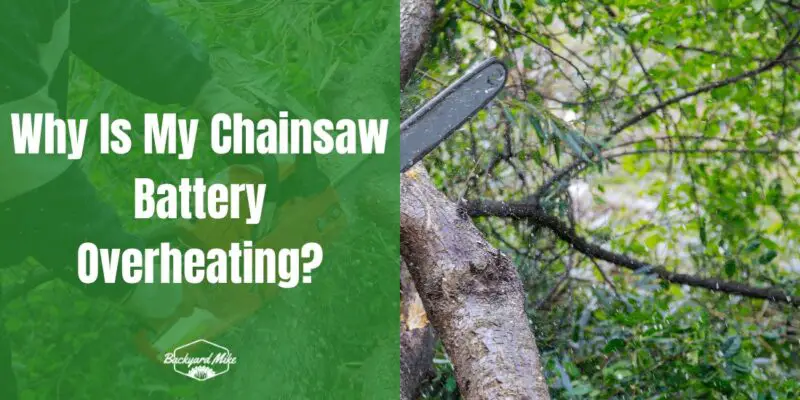Your chainsaw battery is likely overheating due to extended cutting sessions, inadequate ventilation, or poor battery design. Watch for warning signs like swelling, sudden power loss, or unusual heat. To prevent overheating, store batteries in cool locations, use manufacturer-approved chargers, and take breaks during heavy cutting. Regular maintenance including cleaning contact points and inspections can greatly extend battery life. Proper troubleshooting techniques can resolve most thermal issues before permanent damage occurs.
Key Takeaways
- Inadequate battery design or using generic batteries without proper thermal management causes heat accumulation during operation.
- Extended cutting sessions without cooling breaks force batteries to work continuously, raising temperatures beyond safe levels.
- Poor ventilation systems and restricted airflow around the battery prevent effective heat dissipation.
- Dirty or corroded battery connections increase electrical resistance, generating excess heat during power transfer.
- Using incorrect chargers or leaving batteries connected after full charge can trigger thermal runaway conditions.
Common Causes of Battery Overheating in Pole Saws
Battery overheating in pole saws presents a vital operational hazard that requires proper understanding and prevention. The most frequent culprit is inadequate battery design that doesn't allow sufficient space between cells, causing heat to accumulate rapidly during operation. Many entry-level models lack advanced cooling technologies like phase-changing materials that would otherwise dissipate excess heat. Your pole saw's ventilation system plays an essential role too. Poor airflow traps heat within the battery compartment, especially when working in high ambient temperatures or direct sunlight. High-quality materials used in battery chainsaws enhance durability and minimize overheating risks. Quality matters remarkably—generic batteries typically omit the thermal management features found in manufacturer-specific options. Additionally, extended cutting sessions without cooling breaks force your battery to operate continuously at elevated temperatures, accelerating degradation. With environmental regulations driving industry changes, more professionals are adopting battery-powered equipment despite these thermal management challenges. Regular maintenance and proper storage away from heat sources will protect your investment.
Signs Your Chainsaw Battery Is Overheating
Detecting battery overheating early can prevent catastrophic battery failure and extend your chainsaw's operational life.
Look for physical indicators such as swelling or bulging of the battery casing, which signal internal pressure buildup.
Performance issues are reliable warnings—your chainsaw might suddenly lose power, stall during cuts, or deliver inconsistent performance.
You'll also notice markedly reduced runtime between charges and difficulty holding a charge.
Temperature assessment is essential for effective thermal management. Just as gas-powered chainsaws require breaks to prevent engine seizure, battery-powered models need similar considerations.
If your battery feels unusually hot to touch or your chainsaw has triggered built-in temperature alerts, stop using it immediately.
Modern chainsaws equipped with Battery Management Systems provide diagnostic information about overheating conditions.
Always check the manufacturer's temperature guidelines (typically 14°F-122°F) to verify you're operating within safe parameters.
Preventive Maintenance to Keep Batteries Cool
Maintaining your chainsaw battery's ideal temperature requires consistent preventive maintenance practices that extend beyond basic operation. Regular inspections guarantee peak performance while proper charging techniques prevent heat buildup that damages cells. Store batteries in cool, dry locations away from direct sunlight and heat sources, removing them from tools when not in use to prevent residual heat transfer. Implement proper charging techniques by using only manufacturer-recommended chargers with automatic shut-off features, and charge within the 10-29°C temperature range. Clean battery connections regularly to guarantee efficient current flow, preventing resistance that creates excess heat during operation. Cordless chainsaws often feature advanced technology to optimize power usage, helping manage heat generation during use. Schedule maintenance routines seasonally to monitor battery health. When operating in warmer environments, take frequent breaks and consider upgrading to equipment with enhanced thermal protection for extended battery life. Ensuring that ventilation openings remain unobstructed will maintain proper airflow and prevent dangerous heat accumulation in your battery system.
Optimal Operating Conditions for Battery-Powered Chainsaws
Operating your battery-powered chainsaw under ideal conditions considerably extends battery life and enhances cutting performance. For best battery performance, use your saw within 14°F to 122°F (−10°C to 50°C) temperature ranges and avoid rainy conditions. Electric chainsaws are quieter compared to gas-powered models, leading to a more comfortable user experience. Select batteries based on your specific needs—higher voltage (80V) for heavy-duty tasks, while higher Amp-hour ratings deliver longer runtimes. Temperature effects are significant; excessive heat accelerates battery degradation. Proper maintenance includes cleaning battery connections and blowing out cooling slots monthly. Store batteries in cool, dry environments and monitor them regularly for physical damage. Maximize runtime by matching your technique to the task—avoid inefficient chain tension and unnecessary idling. Proper lubrication and appropriate guide bar selection reduce motor strain, preventing overheating. Remember that lithium-ion batteries offer advantages like lightweight design and no memory effect, allowing flexible charging patterns.
Troubleshooting and Solutions for Overheating Issues
Even the best-maintained chainsaw battery can experience overheating issues. When you notice your battery getting excessively hot, first check the connections for debris or corrosion that might impede proper conductivity. Understanding the document appearance elements can help you properly read warning indicators in your chainsaw's manual regarding battery issues.
Your battery maintenance routine should include regularly cleaning these contact points to guarantee peak performance.
- Adjust your charging practices by removing batteries once fully charged and using only manufacturer-recommended chargers
- Take frequent breaks during heavy cutting sessions to allow your battery time to cool down
- Store your batteries at temperatures between 41°F and 77°F when not in use
If overheating persists despite these measures, inspect for physical damage and consult your owner's manual.
Remember that operating in extreme heat will greatly reduce battery efficiency and lifespan.
Frequently Asked Questions
Can a Chainsaw Battery Explode From Overheating?
While rare, your chainsaw battery can explode through thermal runaway if severely overheated. Modern battery safety features minimize this risk, but you'll still need proper handling to prevent dangerous conditions.
How Quickly Does Overheating Permanently Damage Battery Capacity?
Like Icarus flying too close to the sun, your battery's lifespan shortens within hours of severe overheating. Permanent damage occurs within 2-3 heat cycles without proper heat dissipation. Monitor temperatures vigilantly.
Are Aftermarket Batteries More Prone to Overheating Issues?
Yes, aftermarket batteries often lack proper thermal management systems and use lower-quality components. This compromises aftermarket quality and reduces battery lifespan when subjected to your chainsaw's demanding operational requirements.
Should I Refrigerate My Chainsaw Battery Between Uses?
Like a hibernating bear, your chainsaw battery needs proper storage. Don't refrigerate it—this risks moisture damage. Maintain battery storage at room temperature (41-77°F) for ideal performance and temperature effects that preserve longevity.
Can Battery Overheating Damage the Chainsaw's Motor Components?
Yes, excess heat from batteries can damage your motor's electrical components. Proper battery maintenance and overheating prevention protect your investment and extend your chainsaw's operational life.
Conclusion
You've now identified why your chainsaw battery overheats and how to prevent it. Implement proper storage practices, avoid extreme temperatures, and follow maintenance schedules to extend battery life. Studies show that properly maintained lithium-ion batteries retain 80% capacity after 500 charge cycles, while neglected ones may fail after just 150 cycles. Address overheating promptly to maximize your investment and guarantee reliable performance.


